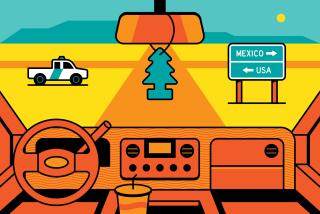Near Zion, an animal sanctuary for people too
- Share via
“It’s so peaceful there. It’s just such a beautiful place to go,” says Michele Johnson of Los Angeles, in nominating Best Friends Animal Sanctuary in Utah.
The setting
Angel Canyon, a postcard-perfect, rust-colored sandstone canyon outside of Kanab, Utah, is home to the Best Friends Animal Sanctuary, said to be the country’s largest no-kill animal shelter.
Amid these 33,000 acres of sand, juniper and sagebrush, volunteers and sanctuary workers have built air-conditioned shelters, offices, banquet halls and outdoor enclosures to house and care for up to 2,000 abandoned animals, including horses, goats, pigs, birds, dogs, cats and rabbits. The rescued animals include 22 dogs confiscated from NFL quarterback Michael Vick’s kennels in the Virginia dog-fighting case.
The sanctuary is a short drive from Zion National Park, the Grand Staircase-Escalante National Monument and the North Rim of the Grand Canyon, an easy side trip for vacationers enjoying some of the Southwest’s best national parks.
The vibe
Workers and volunteers -- up to 4,600 volunteers last year -- feed, groom and care for homeless animals rescued from shelters and homes across the country. Many volunteers are vacationers who stop by to work a day or more, in between visits to nearby national parks. Volunteers can stay at a hotel in the nearby kitsch town of Kanab or rent a cabin, cottages or an RV parking space from the sanctuary. (The cottages resemble economy-priced hotel suites and range from $85 to $110 a night depending on the time of year. Cabins range from $55 to $75.)
Eat at one of several restaurants in Kanab or join the other volunteers for a vegetarian lunch ($4) at the Angel Village banquet hall at the sanctuary.
The facility, funded by private donations, was started in the 1970s by a group of friends from Prescott, Ariz., who came upon a “For Sale” sign on a stretch of land at Angel Canyon that they envisioned could be used to shelter all those dogs and cats that are euthanized daily in shelters across the country.
All the rescued animals at the sanctuary are spayed or neutered, and nearly 75% are adopted into homes.
One of the big drawbacks about the location is the weather. The temperatures here in southern Utah can soar to 110 degrees and higher in the summer. But don’t worry about the animals: Each animal enclosure has a small door that lets the critters escape into separate air-conditioned rooms.
Overall
As I drove across the Utah desert from Las Vegas, I wondered why people would spend their precious few vacation days caring for abandoned animals under the hot summer sun. You’d have to be a bit nutty to trade in a day of hiking through Zion’s sweet clover and Indian paintbrushes to scoop up horse manure or refill dog bowls at an animal sanctuary, right?
The workers insisted that I sign waiver forms and sit through an orientation meeting before working a shift in one of the animal enclosures. That’s understandable considering that a dog bite or bird scratch to a volunteer could lead to costly legal hassle. Visitors can choose to volunteer with just about any type of animal, and if you stay in one of the cabins on the sanctuary property, you can even take a dog to your cabin for a sleepover.
During my shift at the bunny house, I helped clean litter boxes and refill water bowls and cuddled with several fluffy bunnies. I helped sweep and mop the indoor rabbit runs, making them cleaner than my own kitchen floor. The workers here care for hundreds of animals each day, but when one of the rabbits fell ill during my visit, the workers became seriously upset and rushed it to one of the four full-time veterinarians on staff.
I don’t know if the sick rabbit survived, but if not, at least I know it will take a spot in Angel’s Rest, one of the world’s most picturesque pet cemeteries. Hundreds of animals are buried in the shade of juniper trees in neat rows, their graves marked with tiny labels etched with names such as “Miss Tickles” and “Cleocatra.”
The workers and volunteers take on their tasks as if they are changing the world. And for the animals they rescue, they certainly are.
For more information: (435) 644-2001, www.bestfriends.org.
More to Read
Sign up for The Wild
We’ll help you find the best places to hike, bike and run, as well as the perfect silent spots for meditation and yoga.
You may occasionally receive promotional content from the Los Angeles Times.






